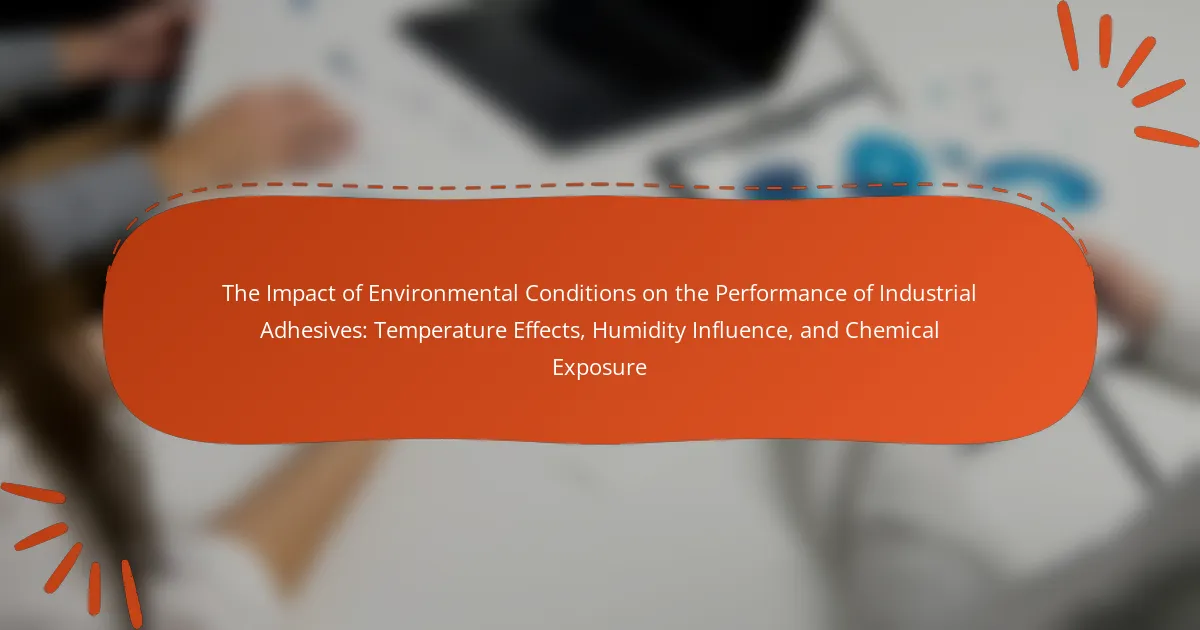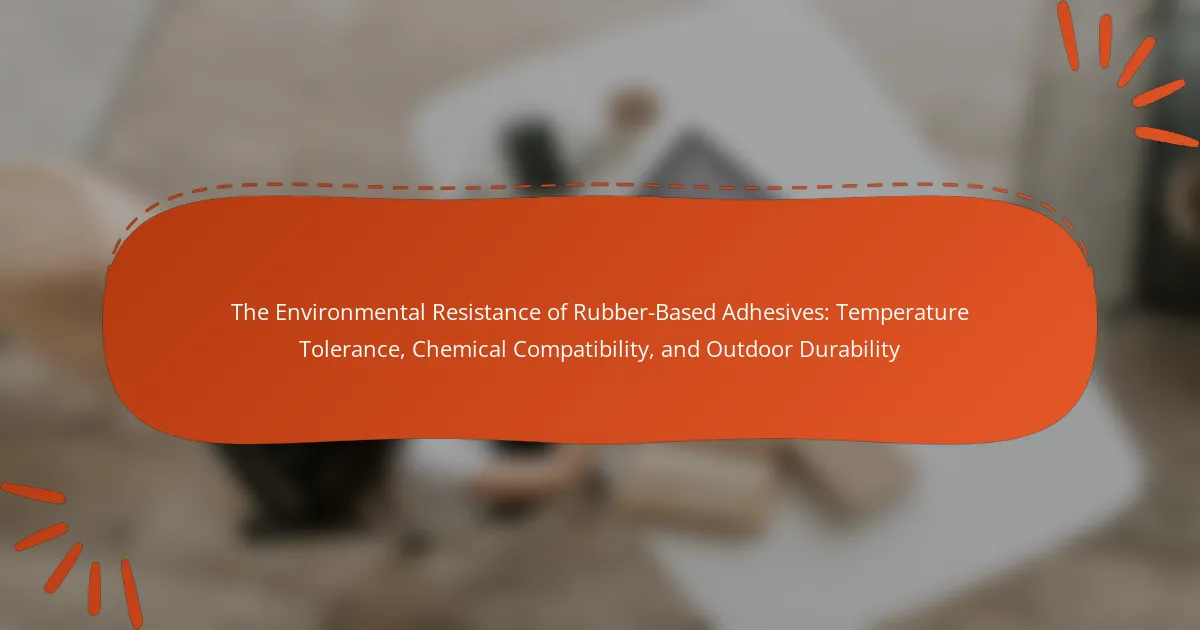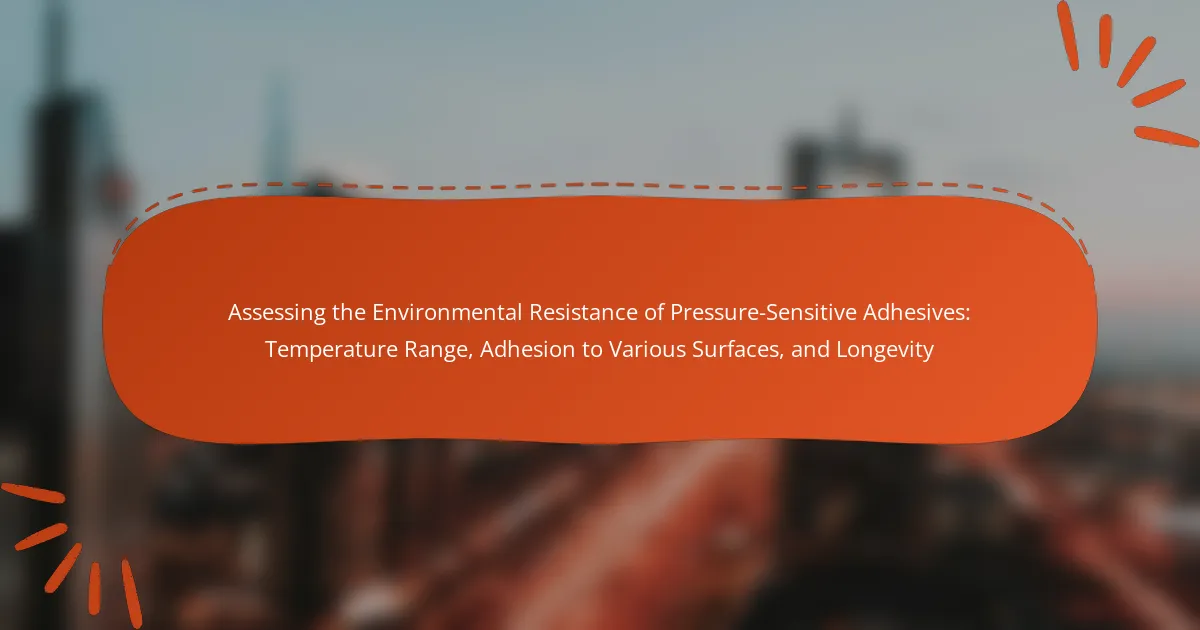The article examines the impact of environmental conditions on the performance of industrial adhesives, focusing on three primary factors: temperature, humidity, and chemical exposure. Temperature plays a critical role in curing processes and adhesion strength, where high temperatures can accelerate curing but may also lead to thermal degradation, while low temperatures can hinder curing and reduce bond strength. Humidity affects moisture-sensitive adhesives, potentially causing bond failure through substrate swelling and reduced adhesion. Additionally, chemical exposure to solvents or corrosive materials can degrade adhesive properties, compromising integrity. The article emphasizes best practices for optimal adhesive performance, including surface preparation, adhesive selection, application thickness, environmental control during application, curing time, and regular quality checks.
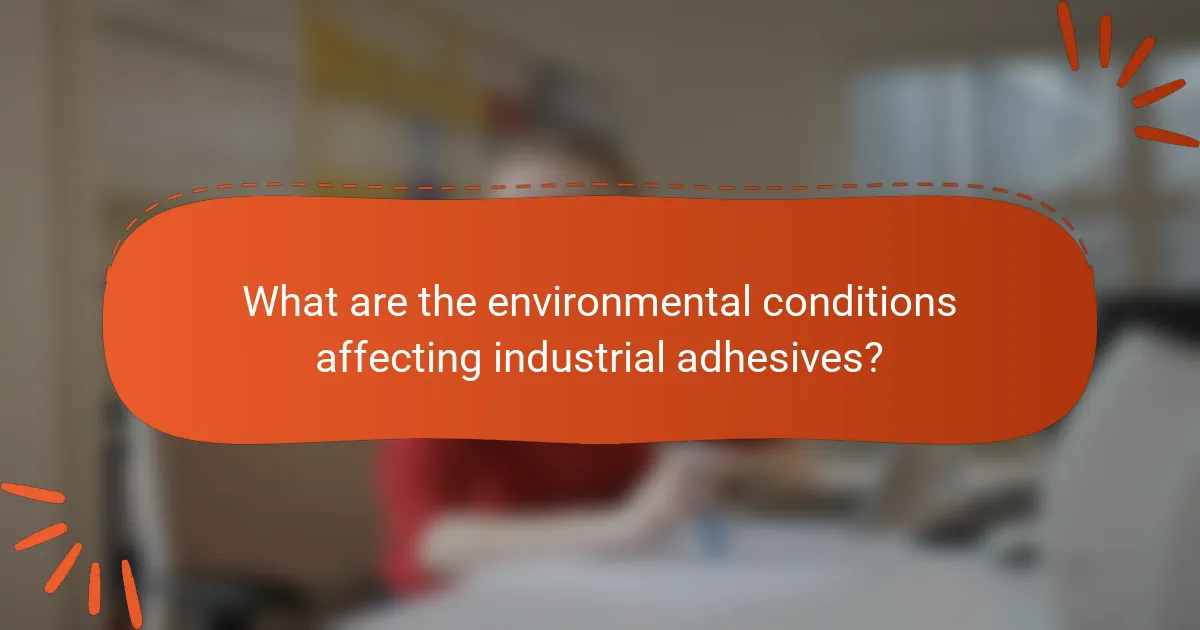
What are the environmental conditions affecting industrial adhesives?
Environmental conditions affecting industrial adhesives include temperature, humidity, and chemical exposure. Temperature influences the curing process and adhesion strength. High temperatures can accelerate curing but may lead to thermal degradation. Low temperatures can slow curing and reduce bond strength. Humidity affects moisture-sensitive adhesives, potentially leading to bond failure. High humidity can cause swelling in substrates and weaken adhesion. Chemical exposure to solvents or corrosive materials can degrade adhesive properties. Each of these conditions directly impacts the performance and durability of industrial adhesives.
How do temperature variations impact the performance of industrial adhesives?
Temperature variations significantly impact the performance of industrial adhesives. High temperatures can accelerate curing processes, leading to faster bond formation. However, excessive heat may also weaken adhesive bonds, causing them to fail under stress. Low temperatures can slow down curing, resulting in longer setup times. In extreme cold, some adhesives may become brittle, compromising their effectiveness. Additionally, temperature fluctuations can induce thermal expansion and contraction in materials, affecting bond integrity. Studies show that adhesives have specific temperature ranges for optimal performance, and deviations can lead to reduced adhesion strength. For example, epoxy adhesives typically perform best between 60°F and 90°F.
What are the optimal temperature ranges for different types of industrial adhesives?
The optimal temperature ranges for different types of industrial adhesives vary. For epoxy adhesives, the ideal temperature range is typically between 60°F to 90°F (15°C to 32°C). Polyurethane adhesives perform best at temperatures from 50°F to 100°F (10°C to 38°C). Acrylic adhesives generally require temperatures between 40°F to 120°F (4°C to 49°C) for optimal bonding. Silicone adhesives function well in a range of 50°F to 120°F (10°C to 49°C). These ranges ensure proper curing and adhesion. Temperature outside these ranges can lead to poor bonding or extended curing times.
How does extreme heat affect the curing process of adhesives?
Extreme heat accelerates the curing process of adhesives. High temperatures increase the reaction rates of the chemical components in adhesives. This can lead to faster setting times and reduced working time. However, excessive heat may also cause premature curing. Premature curing can result in incomplete adhesion and reduced bond strength. It can also lead to issues like bubbling or foaming in the adhesive. Temperature above the recommended curing range can degrade adhesive properties. This degradation can compromise the overall performance and longevity of the bond.
What are the consequences of low temperatures on adhesive bond strength?
Low temperatures negatively affect adhesive bond strength. Adhesives typically lose viscosity and flexibility at lower temperatures. This leads to reduced wetting of surfaces and weaker initial adhesion. Furthermore, low temperatures can cause brittleness in adhesive materials. Brittle adhesives are more prone to cracking under stress. Research shows that bond strength can decrease by up to 50% when temperatures drop significantly. For example, studies indicate that epoxy adhesives exhibit reduced tensile strength at temperatures below 0°C. These factors collectively result in compromised performance of adhesive bonds in cold environments.
In what ways does humidity influence industrial adhesives?
Humidity significantly influences the performance of industrial adhesives. High humidity can lead to reduced adhesive bond strength. Moisture can interfere with the curing process of certain adhesives. This interference results in incomplete polymerization. Additionally, humidity can cause adhesive degradation over time. Some adhesives absorb moisture, leading to swelling and loss of adhesion. Conversely, low humidity may accelerate the curing process for some adhesives. Understanding these effects is crucial for selecting the right adhesive for specific environments.
What is the role of moisture in the adhesion process?
Moisture plays a critical role in the adhesion process by facilitating bond formation between adhesive and substrate. It affects the surface energy and wetting properties of materials. Adequate moisture levels can enhance the flow of adhesives, allowing better [censured] into surface irregularities. This improves mechanical interlocking and chemical bonding. Conversely, excessive moisture can lead to issues like hydrolysis, weakening the bond. Research indicates that optimal humidity levels significantly improve adhesive performance. For example, studies show that adhesives perform best at specific relative humidity ranges, typically between 30% and 70%.
How does high humidity affect the curing time of adhesives?
High humidity generally increases the curing time of adhesives. When humidity levels are high, moisture in the air can interfere with the chemical reactions necessary for curing. Many adhesives rely on evaporation of solvents or moisture to set properly. Excess moisture can slow down these processes. For example, polyurethane adhesives may take longer to cure in humid conditions. Studies have shown that high humidity can lead to incomplete curing, affecting bond strength. Therefore, managing humidity is crucial for optimal adhesive performance.
What are the effects of low humidity on adhesive properties?
Low humidity negatively affects adhesive properties by reducing their bonding strength. Adhesives rely on moisture for optimal curing and adhesion. In low humidity conditions, the evaporation rate of moisture increases. This leads to incomplete curing of water-based adhesives. Consequently, the adhesive bond may become weak or fail. Research indicates that adhesives perform best within specific humidity ranges. For instance, a study by the Adhesive and Sealant Council found that low humidity can decrease bond strength by up to 30%. Therefore, maintaining adequate humidity levels is crucial for effective adhesive performance.
What types of chemical exposure can industrial adhesives encounter?
Industrial adhesives can encounter various types of chemical exposure. These include solvents, acids, bases, and oxidizing agents. Solvents may weaken adhesive bonds by disrupting polymer structures. Acids can cause degradation of certain adhesive materials, leading to bond failure. Bases may also affect the chemical integrity of adhesives, resulting in reduced performance. Oxidizing agents can initiate reactions that compromise adhesive strength. Each type of chemical exposure presents unique challenges to the stability and effectiveness of industrial adhesives. Understanding these exposures is crucial for selecting the right adhesive for specific applications.
How do solvents and chemicals affect adhesive performance?
Solvents and chemicals significantly influence adhesive performance. They can alter the adhesive’s curing process and final bond strength. For instance, solvents may evaporate during application, leading to a weaker bond. Some chemicals can degrade the polymer structure of adhesives, reducing their effectiveness. Additionally, exposure to certain solvents can result in swelling or softening of the adhesive. This can compromise adhesion to substrates. Studies indicate that specific solvents can enhance or inhibit adhesion based on their chemical compatibility. Overall, understanding solvent and chemical interactions is crucial for optimal adhesive performance.
What are the implications of chemical resistance in adhesive selection?
Chemical resistance significantly influences adhesive selection. It determines the adhesive’s ability to withstand exposure to various chemicals without degrading. Choosing an adhesive with appropriate chemical resistance ensures long-term performance and durability in industrial applications. For instance, adhesives used in automotive or aerospace industries must resist fuels, oils, and solvents. Failure to select a chemically resistant adhesive can lead to bond failure and compromised structural integrity. Studies show that improper adhesive selection due to insufficient chemical resistance can result in costly repairs and increased maintenance. Therefore, evaluating chemical exposure conditions is critical in the adhesive selection process.
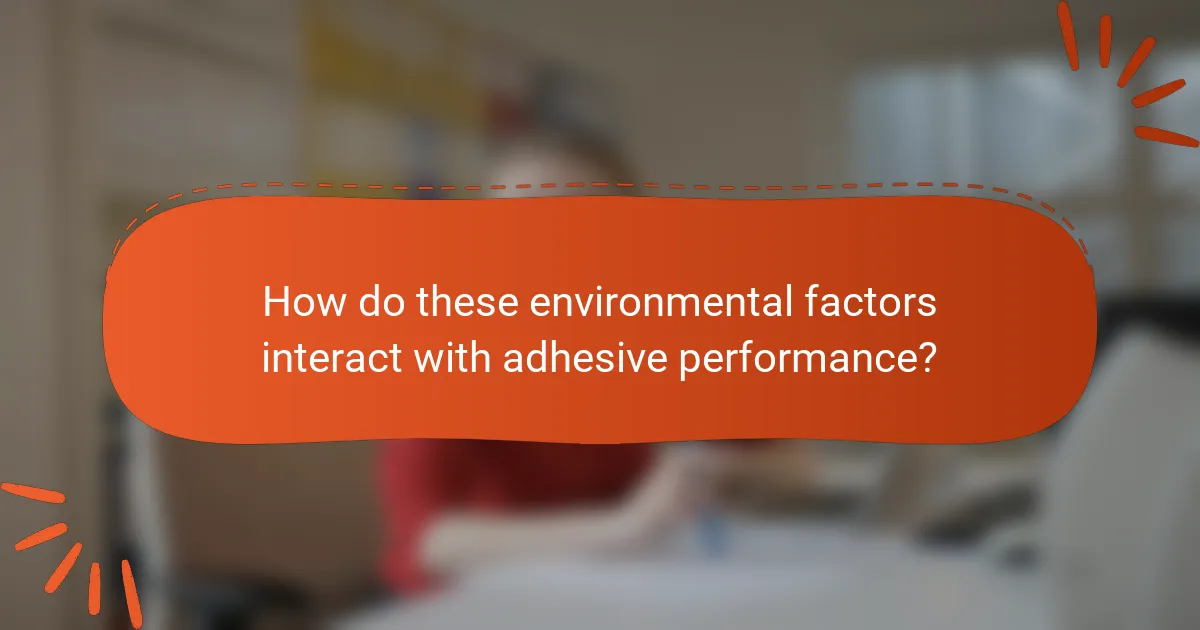
How do these environmental factors interact with adhesive performance?
Environmental factors such as temperature, humidity, and chemical exposure significantly influence adhesive performance. High temperatures can accelerate curing processes but may also weaken adhesive bonds over time. Conversely, low temperatures can slow curing and lead to inadequate bond strength. Humidity impacts moisture absorption, which can reduce adhesion and durability. Increased moisture levels can cause certain adhesives to swell or degrade. Chemical exposure can weaken adhesive bonds, leading to failure. For instance, solvents may break down adhesive components, compromising integrity. Understanding these interactions helps in selecting suitable adhesives for specific environments.
What are the combined effects of temperature and humidity on industrial adhesives?
Temperature and humidity significantly affect the performance of industrial adhesives. High temperatures can accelerate curing times, while excessive humidity may hinder proper adhesion. Adhesives often require specific temperature ranges for optimal bonding. Outside these ranges, adhesive strength can diminish. For instance, elevated humidity can lead to moisture absorption in certain adhesives, weakening their bond. Conversely, low humidity can cause rapid evaporation of solvents, impacting adhesion quality. Studies indicate that adhesives perform best when both temperature and humidity are within recommended levels. Maintaining these environmental conditions is crucial for achieving desired adhesive performance.
How can temperature and humidity variations lead to adhesive failure?
Temperature and humidity variations can lead to adhesive failure by affecting the bond strength and curing process. High temperatures can accelerate the curing of adhesives, resulting in a brittle bond. Conversely, low temperatures can slow down the curing process, preventing proper adhesion. Humidity plays a critical role as well. Elevated humidity levels can cause moisture absorption in certain adhesives, weakening the bond. Furthermore, moisture can lead to hydrolysis, breaking down the adhesive’s chemical structure. Studies show that adhesives exposed to extreme temperature and humidity fluctuations exhibit reduced tensile strength and increased failure rates. For instance, a study by P. K. Gupta and R. Sharma in the Journal of Adhesion Science and Technology found that temperature variations significantly impact the performance of epoxy adhesives under humid conditions.
What strategies can mitigate the adverse effects of temperature and humidity?
Implementing climate control systems can mitigate the adverse effects of temperature and humidity. These systems include air conditioning and dehumidifiers that maintain optimal conditions. Regular monitoring of temperature and humidity levels is essential. This can be achieved using sensors and data logging devices. Proper storage of adhesives in climate-controlled environments prevents degradation. Additionally, using adhesives designed for specific temperature and humidity ranges enhances performance. Training staff on handling materials under varying conditions can further reduce risks. These strategies collectively help maintain the integrity of industrial adhesives.
How does chemical exposure interact with temperature and humidity conditions?
Chemical exposure is significantly influenced by temperature and humidity conditions. Higher temperatures can increase the volatility of chemicals, leading to greater exposure levels. Increased humidity can enhance the absorption of chemicals into surfaces or materials. This interaction can affect the stability and performance of industrial adhesives. For instance, adhesives may degrade faster in high-temperature and high-humidity environments. Studies show that elevated temperatures can accelerate chemical reactions, altering adhesive properties. Conversely, low temperatures can slow down these reactions, impacting adhesion strength. Overall, understanding these interactions is crucial for optimizing adhesive performance in varying environmental conditions.
What are the risks of using adhesives in chemically aggressive environments?
The risks of using adhesives in chemically aggressive environments include degradation, bond failure, and reduced performance. Degradation occurs when adhesives are exposed to harsh chemicals, leading to a breakdown of their molecular structure. This can result in loss of adhesion strength over time. Bond failure may happen if the adhesive cannot withstand the corrosive nature of the environment, causing the bonded materials to separate. Additionally, reduced performance can manifest as changes in flexibility or thermal resistance, impacting the overall integrity of the assembly. According to a study by the Adhesive and Sealant Council, certain adhesives can lose up to 50% of their bonding strength when exposed to specific aggressive chemicals.
How can manufacturers design adhesives to withstand various environmental conditions?
Manufacturers can design adhesives to withstand various environmental conditions by selecting appropriate raw materials. These materials should have properties that resist temperature fluctuations, moisture, and chemical exposure. For instance, high-performance polymers like epoxy and polyurethane are known for their durability.
Additionally, manufacturers can incorporate additives that enhance adhesion and flexibility. These additives can improve the adhesive’s resistance to environmental stressors. Testing adhesives under simulated conditions is crucial. This helps ensure they perform well in real-world scenarios.
Research has shown that adhesives formulated with specific fillers can enhance thermal stability. For example, silica and carbon black are often used to improve heat resistance. Furthermore, proper curing methods can also influence adhesive performance.
By considering these factors, manufacturers can create adhesives that maintain integrity across diverse environments.

What best practices can be followed to ensure optimal adhesive performance?
To ensure optimal adhesive performance, it is essential to follow specific best practices. First, proper surface preparation is crucial. Clean surfaces remove contaminants that can hinder adhesion. Second, selecting the right adhesive for the materials and conditions is important. Each adhesive has unique properties suited for specific applications. Third, applying the adhesive at the recommended thickness enhances bond strength. Too much or too little adhesive can weaken the joint. Fourth, controlling environmental conditions during application is vital. Temperature and humidity can significantly impact curing times and bond quality. Fifth, allowing adequate curing time is necessary for optimal performance. Insufficient curing can lead to bond failure. Lastly, conducting regular quality checks can help identify potential issues early. Research shows that following these practices can increase adhesive bond strength by up to 50% in various applications.
How can industries select the right adhesive based on environmental conditions?
Industries can select the right adhesive based on environmental conditions by assessing temperature, humidity, and chemical exposure. Different adhesives have varying performance characteristics under specific environmental factors. For example, epoxies perform well in high-temperature settings, while polyurethane adhesives are better suited for humid environments. Additionally, some adhesives are formulated to resist specific chemicals. Understanding these attributes allows industries to match adhesive types to their operational conditions. Research indicates that improper adhesive selection can lead to failure in bonding, impacting product integrity. Therefore, evaluating environmental conditions is crucial for optimal adhesive performance.
What factors should be considered in adhesive selection for different applications?
Adhesive selection for different applications should consider factors like substrate materials, environmental conditions, and required bond strength. Substrate materials dictate compatibility and adhesion properties. Environmental conditions include temperature, humidity, and exposure to chemicals. Required bond strength affects the choice of adhesive type and formulation. For instance, high temperatures may require heat-resistant adhesives. Humidity can weaken certain adhesives, necessitating moisture-resistant options. Chemical exposure demands adhesives that can withstand specific substances. Each factor directly influences the adhesive’s performance and longevity in its intended application.
What testing methods can be used to evaluate adhesive performance under varying conditions?
Adhesive performance can be evaluated using various testing methods. Common methods include peel tests, shear tests, and tensile tests. Peel tests measure the force required to separate bonded surfaces. Shear tests assess the adhesive’s ability to withstand sliding forces. Tensile tests evaluate the adhesive’s strength under stretching conditions. Other methods include environmental aging tests and accelerated weathering tests. These tests simulate conditions such as temperature fluctuations and humidity exposure. Each method provides insights into the adhesive’s durability and effectiveness under specific environmental conditions.
What troubleshooting tips can help address adhesive performance issues?
Ensure surface cleanliness before applying adhesive. Contaminants can hinder bonding effectiveness. Verify compatibility between adhesive and substrates. Incompatible materials may lead to poor adhesion. Adjust application temperature according to adhesive specifications. Temperature fluctuations can affect curing and performance. Monitor humidity levels during application. High humidity can cause adhesive failure. Use appropriate curing time as recommended by the manufacturer. Insufficient curing can weaken the bond. Store adhesives according to manufacturer guidelines. Improper storage can degrade adhesive quality. Test bond strength after application. Regular testing ensures reliability and performance.
How can users detect and rectify adhesive failures caused by environmental factors?
Users can detect adhesive failures caused by environmental factors by inspecting for visible signs of delamination or peeling. They should also check for changes in bond strength through manual testing. Environmental conditions like high humidity or extreme temperatures can weaken adhesives. To rectify these failures, users should remove the damaged adhesive and clean the surfaces thoroughly. Selecting an adhesive formulated for specific environmental conditions is crucial. For example, some adhesives are designed to withstand high moisture levels. Applying the new adhesive under optimal conditions enhances performance. Regular maintenance and monitoring of environmental factors can prevent future failures.
What maintenance practices can extend the lifespan of adhesive bonds in challenging conditions?
Regular inspection and timely maintenance can significantly extend the lifespan of adhesive bonds in challenging conditions. Monitoring for signs of degradation is crucial. This includes checking for discoloration, peeling, or loss of adhesion. Proper cleaning of surfaces before reapplication helps maintain bond integrity. Environmental controls, such as regulating temperature and humidity, can also enhance performance. Utilizing protective coatings can shield adhesive bonds from harsh chemicals and moisture. Following manufacturer guidelines for application and storage is essential. Implementing these practices can lead to improved durability and reliability of adhesive bonds under stress.
The primary entity of this article is industrial adhesives, which are significantly influenced by environmental conditions such as temperature, humidity, and chemical exposure. Key factors affecting adhesive performance include optimal temperature ranges for various adhesive types, the impact of high and low temperatures on curing processes and bond strength, and the role of humidity in adhesion quality. Additionally, the article explores how chemical exposure can degrade adhesive properties and discusses best practices for selecting and maintaining adhesives in varying environments. Understanding these interactions is crucial for ensuring the effectiveness and longevity of adhesive bonds in industrial applications.
